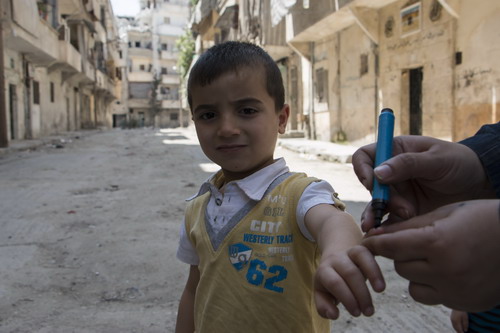 24 April, Cairo/Geneva -- As the international community comes together in Brussels to show support for Syrians and for a political solution to the conflict, WHO calls for increased investments in health to protect the lives of almost 17 million vulnerable men, women and children inside Syria and in 5 major neighbouring countries.
24 April, Cairo/Geneva -- As the international community comes together in Brussels to show support for Syrians and for a political solution to the conflict, WHO calls for increased investments in health to protect the lives of almost 17 million vulnerable men, women and children inside Syria and in 5 major neighbouring countries.
Every day, Syrians are dying of conditions that are easily treatable. Inside the country, critical shortages, insecurity and disrupted systems have left millions of people in need of health aid. Meanwhile, Syrians who have fled to neighbouring countries find themselves just as vulnerable, with the vast majority living below the poverty line and unable to afford life-saving health care.
Syrians at risk due to ongoing health crisis
Seven years into the crisis have left 11.3 million people inside Syria in need of life-saving and life-sustaining humanitarian health aid, while fewer than half of all public health facilities are fully operational. Indiscriminate attacks on health care continue; in 2018 alone, there have been 8 health workers killed or injured and 74 verified attacks on health facilities.
Throughout the country, people are unable to obtain basic, life-saving health care services without being exposed to significant risks on a daily basis. These include almost 2.3 million people in hard-to-reach and besieged areas. Hundreds of seriously ill and wounded people living in besieged areas have been denied the right to leave to obtain life-saving health care. Many of them have died as a result.
Newly accessible areas are often contaminated with explosive hazards, and those who chose to return to their homes may be more at risk of injuries, exacerbated by the lack of basic health care services in many areas of return.
Refugees overburdening health systems in host countries
For almost 6 million Syrian refugees across the Region, the living situation continues to be extremely challenging. Many refugees face psychosocial and physical effects of war and displacement and are in need for primary, secondary and tertiary health care. National health systems across the Region continue to be the primary responders to those health needs, however, access continues to be limited, not only due to overwhelmed and under-funded health systems, but also due to the financial limitations of the refugees themselves.
In addition to millions of Syrian refugees affected by the crisis, an additional 4 million host community members are also affected by the refugee crisis, and in need of aid. In Turkey, where integration of Syrian health care workers into national health systems is well established, language and cultural barriers remain a challenge.
Within the context of the Brussels conference on Syria and the Region WHO emphasizes that health is a human right that must be respected by all parties to the conflict, that the attacks on health workers and facilities must stop, and that there must be adequate investment in the health sector of both Syria and neighbouring host countries. The people of Syria cannot have a future without proper health care.
-------
As part of the 2018 Humanitarian Response Plan for Syria, WHO and health partners require US$ 426.4 m to reach 11.3 million people across the country with life-saving health care services. Of this amount, WHO requires US$ 143 million. To address the health needs of more than 5.3 million Syrian refugees and almost 4 million host community members affected by the Syrian refugee crisis, the health and nutrition sector requires US$ 294 million as part of the Regional Refugee and Resilience Plan for 2018-2019.


